Fool-Proof Wall Framing Tips for New Construction
Updated: Jun. 03, 2019
Learn how to frame a wall and avoid common framing errors with these pro tips on framing a wall.
 Family Handyman
Family Handyman
Learn the simple framing techniques that ensure accurately built, tightly framed walls. This article explains how to frame a wall and the basics of marking up and laying out a wall, along with tips about headers, trimmers and studs.
You might also like: TBD
- Time
A full day
- Complexity
Beginner
- Cost
Varies
Overview of How to Frame a Wall
Framing a wall always looks simple and straightforward, but a mistake here—a wall that's too short or a window opening slightly too small—wastes lots of time and effort later. In this article, we'll show you how to frame a wall and simple techniques designed to ensure accurate results. Keep in mind, though, that carpentry practices and jargon vary from region to region and even from one carpenter to the next. So don't be surprised if some of the labels and marks we show aren't exactly what you'd encounter on a local building project. The basic concepts of how to frame a wall are the same, and with this information your next framing a wall project should go smoothly and error free.
Wood Framing Basics: Snap lines and set the plates in place
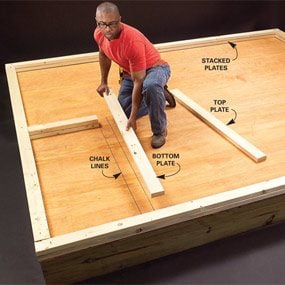
Mark the layout on the floor
Eliminate wood framing basics mistakes by chalking a full-size map of your walls directly on the floor. First mark the inside edge of the wall at each corner and snap chalk lines. Mark the location of interior walls as well and snap chalk lines on both sides of interior wall locations to ensure correct plate positions. Double-check all of your layout lines to make sure the walls are parallel, the corners are at right angles and the dimensions match the plans. Then measure and cut a top and bottom plate for each wall as shown. Double-check lengths by setting the plates in their exact position.
Mark windows and doors first, then lay out the studs
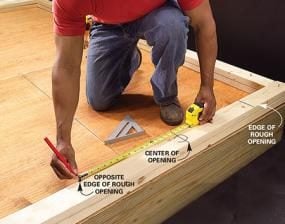
Windows and doors first
Find the center of each window and door opening. Then divide the "rough opening" (given on your plan or in the window literature) by two and measure out to the left and right of the center mark. Write a "T" to the outside of both marks to indicate trimmer locations. Measure over 1-1/2 in. and draw another line. Mark an "X" outside these marks for the full-height king studs.
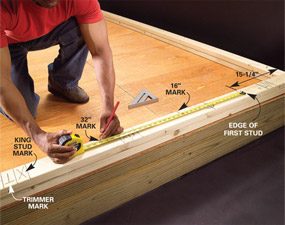
Then mark studs
With the openings marked, lay out the stud locations. The goal is to position the studs every 16 or 24 in. so that the edges of 4×8 sheets of plywood align with the centers of studs. Subtract 3/4 in. from the first layout mark. Then hook your tape on a partially driven nail at this mark, and mark at each 16- or 24-in. multiple. Make an "X" on the same side of each layout mark to indicate the stud position. Mark studs that land between window or door trimmers with a "C" to indicate cripples rather than full-height studs.
Transfer the layout marks to the bottom plate
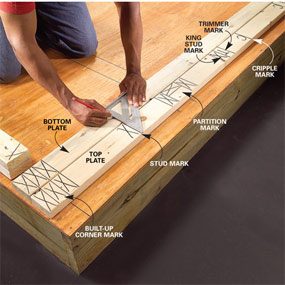
Transfer layout marks
Set the plates side by side and transfer the marks from the top plate to the bottom plate using a square. Some carpenters mark only the edge of the plates. We show marking the wide face, which will help you align twisted studs. Tack the pairs of plates together with 8d nails after marking them so they don't get separated and mixed with other plates. Then set them aside until you're ready to build that wall.
Nail full-height headers to the top plate
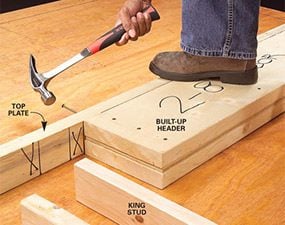
Full-height headers
Calculate header lengths by adding 3 in. to the rough opening width. Add 6 in. to headers that require two trimmers on each side. Cut header parts and nail them together. Label the headers. In many plans, headers are positioned against the top plate. If yours are, begin wall assembly by positioning and nailing these "full-height" headers to the top plate with 16d nails.
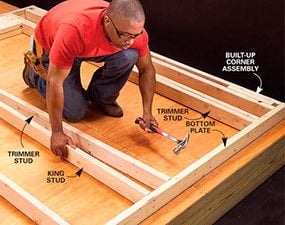
Next, nail studs and trimmers
Lay full-length studs between the plates and nail king studs to the headers and to the top and bottom plates. Nail in all the full-height studs as well as corner assemblies. Note: Sight down each stud before you nail it in and orient any bow (crown) upward. Next install the trimmers.
Add cripples above headers and under sills
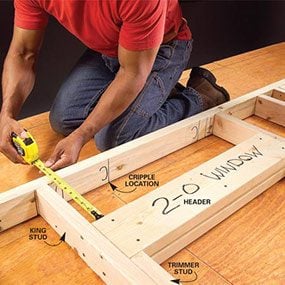
Toenail cripples above headers
In wood framing basics and wall plans that have openings with cripples above the header, cut and nail together the king studs and trimmers first. Then position and nail them to the plates. Set the header on the trimmers and nail through the king studs to hold it in place. Then measure, and nail the cripples into place. You have to toenail the bottom of the cripples to the header.
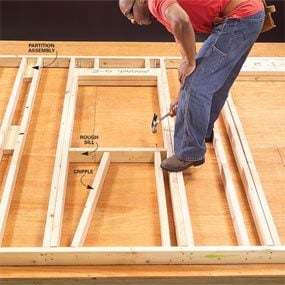
Add sills for windows
Window openings are just like doors but with the addition of a rough sill. Mark the top of the sill by measuring down from the header. Use the rough opening height for this dimension. Cut the lower cripples and place one under each end of the sill as a temporary support while you toenail the sill to the trimmers with a pair of 8d nails at each end. Align the cripples with the layout marks and nail through the sill and bottom plate to hold them in place. Use pairs of 16d nails. Some carpenters like to double the rough sill, especially on openings wider than about 3 ft. If you do this, remember to allow for the thickness of a double sill when you cut your cripples.
Required Tools for this Framing a Wall Project
Have the necessary tools for how to frame a wall lined up before you start—you'll save time and frustration.
Required Materials for this Framing a Wall Project
Avoid last-minute shopping trips for how to frame a wall by having all your materials ready ahead of time. Here's a list.
Originally Published: January 08, 2019









Post a Comment for "Is It Easy to Frame a Wall"